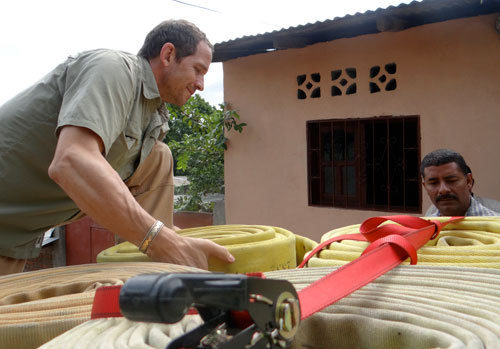How do you know -- without a doubt -- that your donation is going to the right cause? How do you know that your money will be well spent and effective? "The answer begins with doing a little research", says Rodney McDonald, Director of Emergency Response Services for Latin America (ERSLA: www.ersla.org), a nonprofit organization based in Estelí, Nicaragua.
Photo by Henrietta Still. Rodney McDonald unloading a shipment of fire hose to firefighters in Nicaragua.
McDonald has been on the dirty front lines of development work for a decade, based in Nicaragua since his service in the Peace Corps there from 2002 to 2004. McDonald founded ERSLA in 2006; to date, he has helped deliver several tons of much needed firefighting equipment to Nicaragua and has worked on water purification projects that have provided over 1,800 families with safe drinking water. He has worked with many other good people and organizations, and some not-so-effective ones. I asked him what people should know who are thinking about making a year-end (or any time of year) donation. Following were his eight top tips.
1. Do your homework
All registered nonprofits in the United States are required to file a form 990 with the IRS. This is to insure that they aren't working for profit, but are at least attempting to perform the task they are registered to accomplish. Like most information submitted to the IRS, this form is very complicated but does contain valuable information for the donor. This form is also required by the IRS as part of the nonprofit status to be available to the public. This information can be found in many locations, including the following sites: Give Well, Guide Star, and Great Nonprofits.
To research a nonprofit is fairly simple. Go to one of the above listed sites and type in as much information as you know: The name, state in which it is registered, and zip code will work, but it is easier if you have the tax number of the nonprofit you are researching. This is the registration number with the IRS. The number will be listed as two digits then a dash then seven digits. Often you can just put the number into a search engine and find information listed as well about the nonprofit.
2. Understand the difference between relief and development
Relief and development are two different mechanisms for change. Relief is an intervention after a natural disaster or other catastrophic event. It is meant to establish basic needs, usually food, clothing, shelter, health care, or medicines to bring the recipients to a level where they can return to a lifestyle based on conditions prior to the incident. It is truly to help those who cannot help themselves due to specific circumstances. The mechanisms to provide relief usually involve a direct approach of handouts with little or no investment from the recipients.
Development is meant to improve conditions for others, most often those who are in substandard living situations. This requires cooperation and investment from the receivers in order to improve their habits, local infrastructure, or opportunities in an effort to improve overall living conditions. Both relief and development should have an "exit strategy" planned before they begin. The difference is what that should be. The "exit strategy" for relief may be when a certain state of alleviation of trauma, or a level of food distribution networks have been established. In development it can be more difficult to determine; it is not about the "gift giving" of relief, but rather about creating connections.
3. Test communication channels
It's important to know your money is being used as you wish. The organization you are donating to for a cause should have a simple way that you can communicate how and where your money is to be applied. On their website, do they have any way to contact them directly? Is there a physical address listed? Is there a phone number you can call? Try to send an email through their "contact us" methods, make a phone call, find out how responsive they really are. Development work is not only about assisting those in need. In order to be effective it must also educate the donor about the implementations of projects. A nonprofit must be available to answer any questions the donor may have about their donation investment.
4. Offer feedback to the nonprofit
The more nonprofits know about your reasons to donate, the better they can perform. The more communication about how donors would like to be informed of the actions, what social media or other outlets they follow, the better it is for the nonprofit to continue to offer service to the receivers. Also, if you choose to donate to other organizations for any specific reason, or you have a specific reason you chose their cause, let them know so they can make sure that both the receiver and donor are feeling satisfied with the work they are providing.
5. Accept that employment in nonprofits eventually is inevitable
In the case of smaller organizations this can be difficult to understand even within themselves. When a few dedicated people are trying to wear all hats of directors, coordinators, publicists, accountants, administrators, legal advisors and so on, the feeling can become in the minds of these individuals " If I'm performing the work I don't have time to update the donors, if I'm updating the donors, I'm not out performing the work."
Volunteer service is wonderful in the field of nonprofits, but basic needs of transparency and performance can't always be achieved by groups of people who have a few weeks or months available free of salaries and other commitments to continue steady growth within organizations. As the growth of the organization increases and projects and strategies are fine tuned, they can become so complex that by the time a short-term volunteer arrives and is trained, it is time for them to return to "normal life" and a stalemate in production begins. Nonprofits eventually have to offer salaries to individuals to maintain consistent growth and development within an organization, but what happens often is that the donor feels "if 100 percent of my donation is not going to the cause then I don't want to give". But without having key people sustained in an organization it is difficult to have long-term goals and objectives as are essential in development projects.
6. Understand if it was simple it would have already been done
We all love to send in a donation and as soon as possible see results. Most donors from developed countries are accustomed to fast results in their work and creating efficient plans for growth in their personal and professional lives. The reality of most issues in developing countries are problems that have been around for generations, in most cases hundreds of years. There are not many locations on the planet remaining where a group of missionaries, development workers, or just people with big hearts haven't traversed to see how they could help. The underlying issues have taken generations to create and will take generations to resolve, if done with sustainability in mind.
To resolve this dilemma an organization often tries to find a balance. Many organizations have projects that produce quick results to entice a donor. The projects are considered gateway projects for both a receiver and a donor. They are ways to quickly produce successful results where a goal can be achieved quickly and the donor can see their money spent in the a manner that they wish to be done with efficiency. Through these projects, usually the donor can donate to the organization and within a few months receive information about exactly where it was spent with proof of delivery.
These projects are designed to assess the receivers needs and create contact with those who are true "recipients". They are designed to open communication between the community, the nonprofit, but the actual change is hoped to be achieved by identifying future generation leaders of the systems to show alternatives to the current damaged systems and demonstrate the proof of the projects success to the current leaders.
There are not many projects where in a one-time trip to a community from an outside support organization make a difference. They have to be approached as the beginning of a larger plan.
7. Don't believe everything you see
The romance of photos of those in need receiving assistance from others, although warming to the heart of the donor, are often not the foundation of development that actually is producing results. Many of the major accomplishments may be realized more in private meetings with government officials after influence has been achieved by the administrators and coordinators of projects. These usually aren't great photo opportunities, but rather the real work that does eventually make a change. Make sure to understand the overall objective of the nonprofit you choose to know it is working toward a goal you agree with.
8. Remember no matter how large or small your donation is, it alone most likely will not make much of a change
Most problems found in the developing world today are greater than any individual or group can resolve. Unless multiple nonprofits and mission groups are working in unison to resolve real issues, then things will never change. It is great that someone is improving education, but without adequate nutrition and sanitation a great school will not be of much use if the students aren't able to concentrate. Sanitation relies on adequate infrastructure which relies on local municipal income of sorts to maintain which relies on economic development. There are many debates on what is the key to development, what area is most important.
The real answer is ALL are important! Research if the organization you are donating your time or money to is working along with others in diversified areas of development. They don't necessarily need to work side by side, but at least have some method of communication to understand others goals and strategies to find baseline solutions to the overall problems.
This post originally appeared on The Tranquilo Travel

